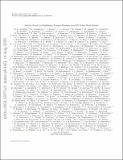IceCube Search for High-energy Neutrino Emission from TeV Pulsar Wind Nebulae
Author(s)
Conrad, Janet
DownloadAccepted version (1.943Mb)
Terms of use
Metadata
Show full item recordAbstract
© 2020. The American Astronomical Society. All rights reserved.. Pulsar wind nebulae (PWNe) are the main gamma-ray emitters in the Galactic plane. They are diffuse nebulae that emit nonthermal radiation. Pulsar winds, relativistic magnetized outflows from the central star, shocked in the ambient medium produce a multiwavelength emission from the radio through gamma-rays. Although the leptonic scenario is able to explain most PWNe emission, a hadronic contribution cannot be excluded. A possible hadronic contribution to the high-energy gamma-ray emission inevitably leads to the production of neutrinos. Using 9.5 yr of all-sky IceCube data, we report results from a stacking analysis to search for neutrino emission from 35 PWNe that are high-energy gamma-ray emitters. In the absence of any significant correlation, we set upper limits on the total neutrino emission from those PWNe and constraints on hadronic spectral components.
Date issued
2020Department
Massachusetts Institute of Technology. Department of PhysicsJournal
Astrophysical Journal
Publisher
American Astronomical Society
Citation
Conrad, Janet. 2020. "IceCube Search for High-energy Neutrino Emission from TeV Pulsar Wind Nebulae." Astrophysical Journal, 898 (2).
Version: Author's final manuscript